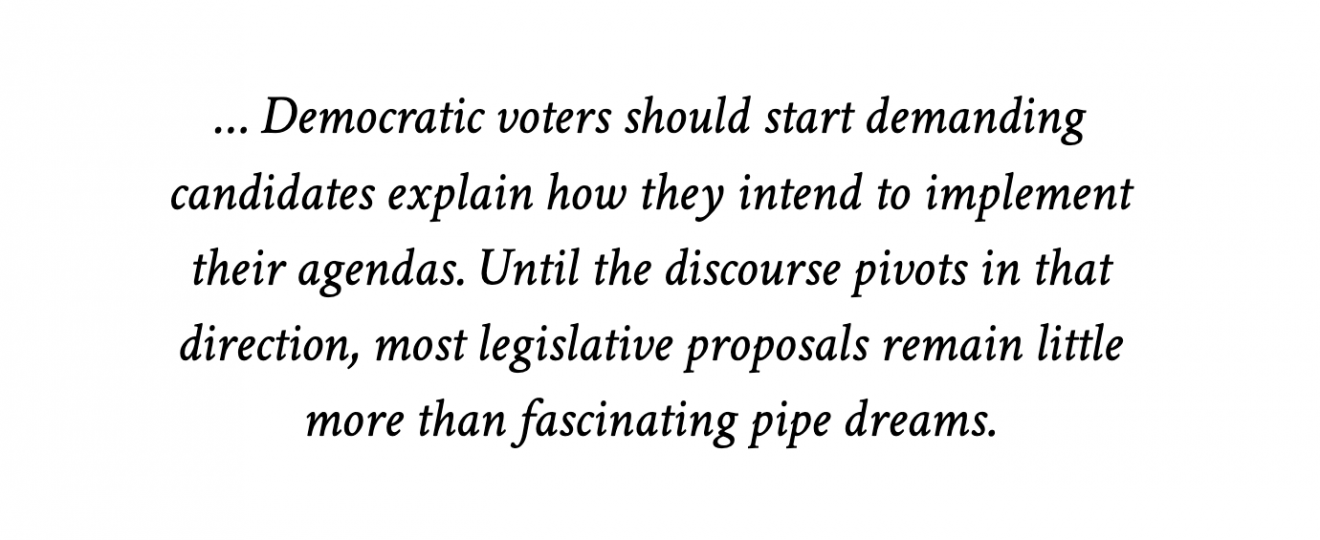The American Left is winning.
For the first time since Johnson’s Great Society, the Democratic party is shifting to the left on a broad range of issues. Just take a look at the 2020 candidates: safe for Amy Klobuchar (a self-avowed moderate who has already faced a significant hurdle after allegations of mistreatment of employees emerged) all the major figures who are running are doing so as proud progressives.
Now, obviously, not all candidates are equally progressive or committed to deep socio-economic change- deeming Kamala Harris as left wing as Elizabeth Warren would be plainly wrong. But the fact of the matter is that ‘liberal’ and ‘progressive’ (which have very different meanings but are for the most part used interchangeably in the American political discourse) have replaced ‘moderate’ and ‘fiscally-responsible’ as the epithets most desired by upcoming politicians. The cocktail of political newcomers and anti-Trump backlash has pushed a cascade of new policy ideas into the mainstream, from Medicare For All to the ambitious anti-poverty, anti-climate change New Deal. There has even been a drastic shift in foreign policy (where Republican-sponsored interventionism has been the norm since the Eisenhower administration) with many 2020 candidates defending congresswoman Ilhan Omar’s stance against Israel.
All of the above calls for celebration. Yet perhaps caution would serve Democrats best.
Now, I don’t mean caution in the classical sense, that of moderating ideology and reducing the scope of ambitious policy in the hopes that ‘bipartisanship’ will suddenly overcome decades worth of asymmetric polarisation. Republican attitudes during the Obama administration proved the futility of such an approach. Instead, the American left needs realistic caution, awareness of the huge obstacles it must overcome to enact a fraction of its agenda, even if a Democratic candidate wins the 2020 election.
Perhaps the single biggest hurdle to the passing of progressive legislation is the Senate. As of today, Democrats can count on 47 votes (45 Democratic senators plus two independents who caucus with them) which means they will need a net gain of three seats to regain a majority, assuming they win the presidency and hence the vice president’s tie breaking vote. However, that outcome is far from assured- only Republicans Susan Collins from Maine and Corey Gardner represent Democratic states, and the former has proven able to remain above partisanship, winning by over 22 percentage points just as Obama carried the state by seventeen. Further, Democrat Doug Jones from Alabama is unlikely to win re-election (unless a pedophile wins the Republican nomination again) meaning the party will probably need to win Maine, Colorado and two Republican leaning states, aside from holding onto the remainder of their seats. This is largely due to the structure of the Senate, which rewards small southern states where Democrats tend to underperform. In fact, given the makeup of the chamber, it is surprising the party can ever be competitive at all. If one were to allocate the seats according to the Cook Partisan Voting Index (which measures the baseline political lean of the states) Democrats could expect 43 seats to Republicans 57.
Yet even if the Democrats won a majority in the upper chamber, it would prove challenging, if not outright impossible to pass some of the progressives’ most ambitious projects under current procedural rules. Major legislation in the US Senate currently requires 60 votes- a ‘filibuster-proof’ majority- to pass. This historically recent rule effectively ingrained conservatism into the institution, making any legislative change extremely hard in our partisan era. Indeed, the odds of a Democratic supermajority in the Senate are approximately equal to those of Donald Trump suddenly becoming a Bernie convert and pushing Medicare for All through Congress. The 2022 map would give them slightly larger odds, but the incumbent’s party tends to fare poorly in midterm elections. Some legislation could be passed through the budget reconciliation process, but it would be limited in scope- Medicare For All, for instance, would be unattainable (even the more modest Affordable Care Act would have been ineligible for the reconciliation process). Even then, legislation would almost certainly be watered down until it was deemed acceptable to the more conservative members of the Democrat Caucus, such as Joe Manchin, who called Obamacare ‘far too reaching’ and is unlikely to risk his political career for a progressive bill after narrowly winning in 2018. If the Senate’s structure remains unchanged, it is rather plausible that the Left will find itself with no signature legislature to show for its struggle.
Note that the Senate could be reformed to achieve a fairer, less conservative representation. For one, the filibuster could be abolished with a simple majority, easing the path broad ranging legislative change. Alternatively, Congress could grant statehood to DC and Puerto Rico through a simple majority vote, almost certainly giving Democrats four extra senators (and, more importantly, ensuring their citizens actually have political representation beyond non-voting delegations).
However, neither of these options have gained support among top Democratic contenders. Only Elizabeth Warren has endorsed eliminating the filibuster (Sanders, Harris, Gillibrand and Booker have spoken out against it) and the issue of increased statehood has barely registered at all. The candidates have focused on endorsing ambitious policy proposals (Green New Deal, Medicare For All, Anti-Poverty Acts, HR-1) that have very little chance of being passed under current rules. This shows either a concerning lack of awareness of the political landscape or, more likely, an unwillingness to deal with the complex issue of Republican overrepresentation at every level of the federal government, be it through the anachronic electoral college (Democrats have only lost the popular once since 1992, but the electoral college has kept them out of the white house for 12 years), gerrymandered House Districts or a structurally reactionary upper chamber. A more cynical take would be that many of these newly left-wing politicians (such as Gillibrand, who after serving as a pro-gun rights representative has pivoted sharply to the left, or Booker, who until recently supported charter schools and has deep ties to large pharmaceuticals) would be glad to have a Republican filibuster that allows them to backtrack on the progressive proposals they are using as stepping stones to the nomination.
Either way, Democratic voters should start demanding candidates explain how they intend to implement their agendas. Until the discourse pivots in that direction, most legislative proposals remain little more than fascinating pipe dreams.




